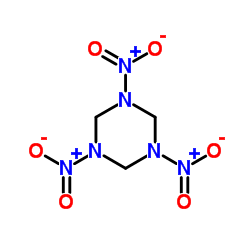Cyclotrimethylenetrinitramine

Cyclotrimethylenetrinitramine structure
|
Common Name | Cyclotrimethylenetrinitramine | ||
|---|---|---|---|---|
| CAS Number | 121-82-4 | Molecular Weight | 222.116 | |
| Density | 1.9±0.1 g/cm3 | Boiling Point | 747.0±50.0 °C at 760 mmHg | |
| Molecular Formula | C3H6N6O6 | Melting Point | 205ºC | |
| MSDS | N/A | Flash Point | 405.6±30.1 °C | |
| Symbol |



GHS02, GHS07, GHS08 |
Signal Word | Danger | |
|
Transport and dissolution of microscale Composition B detonation residues in porous media.
Chemosphere 107 , 400-6, (2014) The deposition of military explosive residues on training ranges has resulted in extensive contamination of land and water resources. Experiments were performed to examine the transport and dissolution of mm-sized and microscale Composition B (Comp B) residue... |
|
|
Phytoremediation of explosives (TNT, RDX, HMX) by wild-type and transgenic plants
J. Environ. Manage. 113 , 85-92, (2012) The large-scale production and processing of munitions has led to vast environmental pollution by the compounds TNT(2,4,6-trinitrotoluene), RDX(hexahydro-1,3,5-trinitro-1,3,5-triazine) and HMX(octahydro-1,3,5,7-tetranitro-1,3,5,7-tetrazocine). Explosives cont... |
|
|
Direct liquid deposition calibration method for trace cyclotrimethylenetrinitramine using thermal desorption instrumentation.
J. Chromatogr. A. 1282 , 178-82, (2013) A simple method for establishing calibration curves with sorbent-filled thermal desorption tubes has been demonstrated for nitroaromatic and nitramine vapor samples using a thermal desorption system with a cooled inlet system (TDS-CIS), which was coupled to a... |
|
|
Modeling the dissolution of various types of mixed energetic residues under different flow conditions.
J. Hazard. Mater. 235-236 , 138-43, (2012) Energetic residues are scattered around active ranges due to the detonation events and dissolution is usually the first step for the entry of explosive compounds into the environment. The current models for describing the dissolution are subject to limitation... |
|
|
Soil properties affect the toxicities of 2,4,6-trinitrotoluene (TNT) and hexahydro-1,3,5-trinitro-1,3,5-triazine (RDX) to the enchytraeid worm Enchytraeus crypticus.
Environ. Toxicol. Chem. 32(11) , 2648-59, (2013) The authors investigated individual toxicities of 2,4,6-trinitrotoluene (TNT) and hexahydro-1,3,5-trinitro-1,3,5-triazine (RDX) to the potworm Enchytraeus crypticus using the enchytraeid reproduction test. Studies were designed to generate ecotoxicological be... |
|
|
Incorporation and mineralization of TNT and other anthropogenic organics by natural microbial assemblages from a small, tropical estuary.
Environ. Pollut. 174 , 257-64, (2013) 2,4,6-Trinitrotoluene (TNT) metabolism was compared across salinity transects in Kahana Bay, a small tropical estuary on Oahu, HI. In surface water, TNT incorporation rates (range: 3-121 μg C L(-1) d(-1)) were often 1-2 orders of magnitude higher than mineral... |
|
|
Ultra-violet and visible absorption characterization of explosives by differential reflectometry.
Spectrochim. Acta. A. Mol. Biomol. Spectrosc. 105 , 149-55, (2013) This study presents some optical properties of TNT (2,4,6-trinitrotoluene), RDX, HMX and tetryl, specifically their absorption spectra as a function of concentration in various solvents in the ultraviolet and visible portion of the electromagnetic spectrum. W... |
|
|
Fluorescent proteins as biosensors by quenching resonance energy transfer from endogenous tryptophan: detection of nitroaromatic explosives.
Biosens. Bioelectron. 48 , 251-7, (2013) Ensuring domestic safety from terrorist attack is a daunting challenge because of the wide array of chemical agents that must be screened. A panel of purified fluorescent protein isoforms (FPs) was screened for the ability to detect various explosives, explos... |
|
|
Biochar-mediated reductive transformation of nitro herbicides and explosives.
Environ. Toxicol. Chem. 32(3) , 501-8, (2013) Biochar, a subset of black carbon produced via pyrolysis of biomass, has received much attention in recent years due to its potential to address many important issues, from energy and climate to agriculture and environmental quality. Biochar is known to influ... |
|
|
Interspecific effects of 4A-DNT (4-amino-2,6-dinitrotoluene) and RDX (1,3,5-trinitro-1,3,5-triazine) in Japanese quail, Northern bobwhite, and Zebra finch.
Ecotoxicology 22(2) , 231-9, (2013) The purpose of this study was to assess the toxicological effects of two munition compounds, 4-amino-2,6-dinitrotoluene (4A-DNT) and 1,3,5-trinitro-1,3,5-triazine (RDX), on three different bird species: two common toxicological model species-the Northern Bobw... |